Effects of shrubs and precipitation on spatial-temporal variability of soil temperature in microhabitats induced by desert shrubs
YaFeng Zhang ,XinPing Wang ,Rui Hu ,YanXia Pan
1.Shapotou Desert Research and Experiment Station,Cold and Arid Regions Environmental and Engineering Research Institute,Chinese Academy of Sciences,Lanzhou,Gansu 730000,China
2.University of Chinese Academy of Sciences,Beijing 100049,China
1 Introduction
Arid and semi-arid ecosystems are often characterized by vegetation patchiness,arranged as a two-phase mosaic of discrete vegetated patches surrounded by bare ground patches (Noy-Meir,1973;Rietkerket al.,2004).Patchy vegetation,through shading and increasing surface roughness,produce ecologically important microclimates (soil and air temperature,humidity,wind speed,solar radiation,soil evaporation) under their canopies in desert ecosystems(Vetaas,1992;Moroet al.,1997;Tracolet al.,2011).These microclimates greatly affect near-surface biological processes including seed germination (Valientebanuet and Ezcurra,1991;Mayoret al.,2007),soil seed banks (Price and Reichman,1987;Wanget al.,2010),seedling establishment,survival and growth (Franco and Nobel,1989;Castellanoset al.,1999;Ludwiget al.,2001;Griffith,2010),microbial activity (Gobernaet al.,2007;Jiaet al.,2010),root growth (Macduffet al.,1986),and insect population dynamics (Carpinteroet al.,2011;Shelef and Groner,2011).
Sparse vegetation in desert ecosystems is usually interspersed by large patches of unshaded bare soil,which makes the desert landscape also a patchwork of sharply contrasting thermal environments (Bouletet al.,1999;Molles,2008).Desert soil temperatures are very high during the day,which often become lethal for seedlings of many species (Nobel,1984).Shrubs are reported to provide amelioration from high or even extreme surface temperature characteristics of desert environments and further lessen soil evaporation at the microscale level through a direct shading effect (Lowe and Hinds,1971;Nobel,1984;Souch and Souch,1993) by reducing solar radiation reaching the shaded area (Scholes and Archer,1997).Solar radiation is greatly attenuated through shrub canopy(Thomas and Kliebenstein,2000),and the size and shape of shade is determined both by canopy architecture and the diurnal variation of solar altitude (Kuuluvainen and Pukkala,1989;Raz-Yaseefet al.,2010;Zouet al.,2010).Soil temperature variation characteristics,such as annual,monthly and diurnal variation of soil temperatures and vertical fluctuations of soil temperatures,in different ecosystems and their causative factors have been systematically studied (Yanget al.,1999;Wanget al.,2002;Wanget al.,2003;Liet al.,2005;Song and Wang,2006;Zhanget al.,2009).However,less work has been done relating the effects of desert shrubs on soil temperature variations at different microhabitats.Moreover,precipitation is scarce and unpredictable with large intra-and interannual variations in arid areas.The precipitation input is pulsed and is an important or even the only source of soil water replenishment (Noy-Meir,1973),which is extremely important for vegetation growth in desert ecosystems.Therefore,it is necessary to assess the effects of shrubs on soil temperatures either during rainfall events as well as after the cessation of rainfall.Here,we mainly aimed to characterize the effects of both shrub (Caragana korshinskiiKom.) canopy and precipitation on the spatial and temporal variation of soil temperature,and further discuss the ecological role of the establishment of revegetation systems in the development of microhabitats in a revegetated desert ecosystem.
2 Materials and methods
2.1 Study area
Measurements were conducted between August 4 and 31 of 2011 at the Water Balance Experimental Field (WBEF),Shapotou Desert Research and Experiment Station (SDRES)of Chinese Academy of Sciences (37°32′N,105°02′E;elevation of 1,300 m above sea level),located at the southeastern fringe of the Tengger Desert in northwestern China.Mean annual precipitation is only 191 mm (1955-2005,SDRES) with 80% of rain occurring between July and September,and precipitation is the only source of soil water replenishment.Mean maximum air temperature is 24.7 °C in July and the mean minimum is-6.1 °C in January.Maximum surface temperature can reach to 74 °C during summer months.Potential evapotranspiration is as high as 2,500 mm during the growing season,resulting in a large annual moisture deficit.The area is surrounded by relatively plain interdunes and free from any disturbances of grazing,fire,and wood chopping.The dune sand mainly consists of fine sand(0.05-0.25 mm),and the clay content is about 0.2%.The sand can thus be classified asTypicPsammaquents(Berndtssonet al.,1996).
WBEF,1 hectare,was one of the revegetated enclosures here,established in 1989,revegetated withC.korshinskiiandArtemisia ordosicaKrasch.After approximately 20 years of succession,landscape in the WBEF has been transformed from the former sand dune into a landscape characterized by a mosaic of sparse shrubs and herbs and bare interspaces covered by thin biological soil crusts.
2.2 Experimental design and field measurements
A robust and healthy adult shrub ofC.korshinskiiwas chosen,which is a multi-stemmed deciduous perennial shrub and looks like an inverted cone.Leaves are pinnately compound and opposite or sub-opposite in arrangement and 6 to 10 cm long.Each pinna has 6 to 8 pairs of leaflets which are ovate in shape,3-10 mm in length and 4-6 mm in width.The targeted plant is 200 cm in height with a canopy size (east-west × north-south) of 250cm×230cm and a LAI(leaf area index) of 0.59.It has 10 stems and the average stem diameter is 2.4 cm.
Soil temperatures were measured by a CB-0221 multipoint temperature measurement system (Siaidi Ecological Scientific Instruments Co.,Ltd.,Beijing,China) with a measurement range from-40 to 60 °C and an accuracy of±0.1 °C.Soil temperature data were automatically recorded with a frequency of 30 min.Probes were set up at 0,5,10 and 20 cm of soil depths beneath shrub canopy and in the bare intershrub spaces (free from shading),respectively.Measurement points represent typical microhabitats experiencing shading by shrub canopy and free of shading,respectively.It is worth noting that in the daytime there is a dynamic shading area at soil surface around shrubs,varying with the diurnal variation of solar altitude.Moreover,solar radiation attenuates when it penetrates the canopy gaps.Therefore,the measurement points of soil temperature at soil surface beneath shrub canopy experiences dynamic shading in the daytime.
Rainfall data were derived from a standard tipping bucket rain gauge (Adolf Thies GMVH &Co.KG,Germany)with a resolution of 0.1 mm and a mini logger recorded ten-minute rainfall intensity values within WBEF.
3 Results
3.1 Daily mean soil temperature and daily precipitation amount
Figure 1 illustrates daily precipitation amount and daily mean soil temperature at different depths beneath shrub canopy (BSC) and in the bare intershrub spaces (BIS) during the experiment.A total of seven rainfall events during the study period were recorded.No rainfall occurred during August 4 to 14,and soil temperatures at the different depths in the BIS were higher than within the BSC area,which indicates that the shrub play a notable role of "cool islands".Moreover,soil temperature decreased with increasing depth.Four rainfall events occurred during August 15 to 18,with a depth of 21.3,12.0,18.8 and 2.4 mm,respectively.Soil temperatures sharply decreased after the rainfall on August 15 compared to the previous days without rainfall,and the decreased tendency continued in the next three days until the cessation of the rainfall.Moreover,little difference was found in soil temperatures within the BSC area and in the BIS after rainfall,which suggests that "cool islands" effects induced by shrub canopy disappeared after rainfall.Soil temperature began to recover in August 19 without rainfall and soil temperatures in the BIS were higher than within the BSC area.A rainfall of 0.1 mm occurred in August 21,but it had little influence on soil temperature recovery.There were 11.0 and 0.8 mm rainfall in August 23 and 24,respectively,and once again,soil temperature decreased.No rainfall occurred during August 25 to 31,and soil temperature increased day by day during this period.

Figure 1 Daily mean soil temperature and daily precipitation amount during the experiment (August 4-31).UC-0,UC-5,UC-10 and UC-20 represent soil temperatures at depths of 0 cm,5 cm,10 cm and 20 cm within the BSC area,respectively.IS-0,IS-5,IS-10 and IS-20 represent soil temperatures at depths of 0 cm,5 cm,10 cm and 20 cm in the BIS,respectively
3.2 Diurnal variations of soil temperature in clear days
Figure 2 is the diurnal variations of soil temperature within the BSC area and in the BIS in a typical clear day(August 6).The diurnal variations of soil temperature show a sinusoidal curve.Soil temperature firstly decreased and then increased until attaining its maximum,and then sharply decreased,and finally slowly decreased.The inflection points varied with soil depths and they were also different between BSC and BIS.For instance,the inflection points of soil surface temperature within the BSC area occurred at 6:00 (slow decrease to increase),14:00 (attaining the maximum) and 21:00 (sharp decrease to slow decrease).7:00 is the time around sunset,and surface temperature sharply increases with increasing solar radiation.Solar radiation reached its peak around local noon along with highest air temperature.Soil temperatures have time lags compared to air temperature,and the peak soil surface temperatures occurred at 14:00 to 15:00.However,after sunset,surface temperature began to decrease due to surface radiation cooling.In contrast,the inflection points of soil temperature at 20 cm in the BIS occurred at around 11:00 (slow decrease to increase) and 21:00 (attaining the maximum).This is because heat in the soil is transferred from upper soil layers to deeper soil layers,and there are time lags of maximum soil temperature at 20 cm compared to soil surface.Moreover,vertically,the magnitude of the diurnal variations of soil temperature decreased with increasing soil depths.It is expected that the diurnal variations of soil temperature would close to a straight line after a certain soil depth.
Due to the shading effect of shrubs,surface temperature(0 cm) beneath shrub canopy had a pronounced fluctuation with time.Surface temperatures within the BSC area were slightly higher than in the BIS between 7:00 (around sunrise)and after 21:00 (around sunset),while surface temperatures within the BSC area were remarkably lower than in the BIS between 7:00 and 21:00,suggesting a "warm islands" effect in the nighttime (sunset to sunrise) and a "cool islands" effect in the daytime (sunrise to sunset) induced by shrub canopy.However,soil temperatures at other soil depths (5,10 and 20 cm) within the BSC area were lower than in the BIS for the whole day.
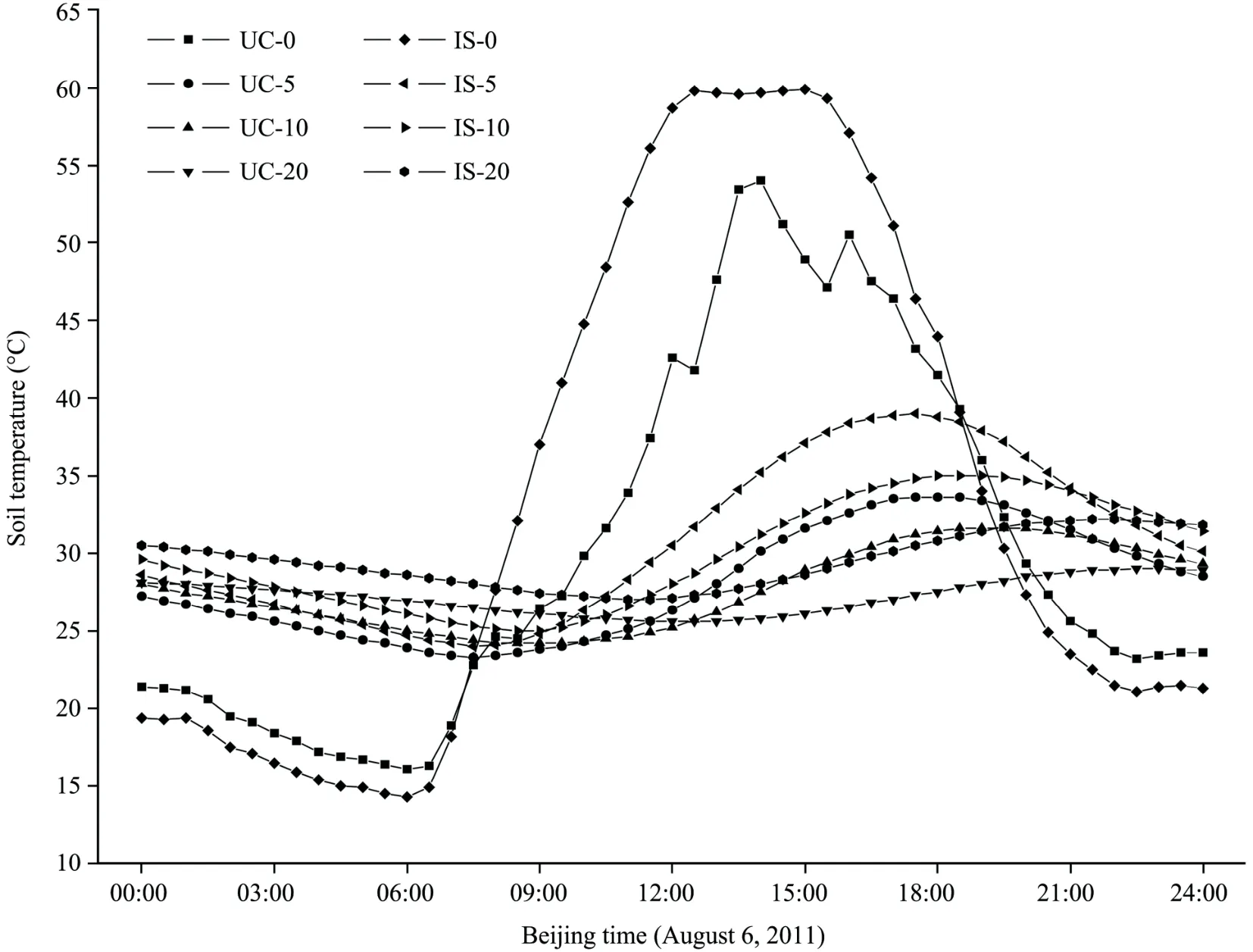
Figure 2 Diurnal variations of soil temperature that are within the BSC area and in the BIS in a typical clear day (August 6)
Figure 3 shows the vertical fluctuations of soil temperature that are within the BSC area and in the BIS in a typical clear day (August 6).We chose four typical times of the day(01:00,08:00,14:00 and 19:00) for analysis.At 01:00,08:00 and 14:00,the vertical variations of soil temperature showed similar tendency,but there was a slight difference at 19:00.The four typical curves were:(1) at 01:00,soil temperature increased with increasing soil depth,which was mainly caused by radiation cooling at soil surface in the nighttime.This type of vertical variation of soil temperature occurred between 21:00 to 07:00 in the next morning.(2) At 08:00,soil temperature decreased and then increased with increasing soil depth,with a higher soil temperature at a soil depth of 20 cm than at other soil depths.This type of vertical variation of soil temperature mainly occurred at a short time after sunrise (08:00 to 09:00).At this time period,soil surface temperature had a relatively quick increase because of increasing solar radiation and it was higher than at 5 cm but lower than at 20 cm with the lowest soil temperature occurred at 15 cm.(3) At 14:00,soil temperature decreased with increasing soil depths.This type of vertical variation of soil temperature mainly occurred between 10:00 to 18:00.(4)At 19:00,soil temperatures beneath shrub canopy first increased and then decreased with increasing soil depth.This type of vertical variation of soil temperature mainly occurred in a short time period after sunset (around 19:00 to 20:00).Soil temperature at the surface began to decrease with decreasing soil radiation,while soil temperatures at deeper soil layers kept a higher level,with the highest soil temperature occurred at 15 cm.Due to the influence of shrub canopy,there was a 1 h time lag in the decreasing velocity of surface temperature at BSC than in the BIS.
Figure 4 displays the diurnal mean variations of soil temperature during the experiment (August 4 to 31).The diurnal mean variations of soil temperature had a similar tendency with that in clear days (e.g.,August 6).
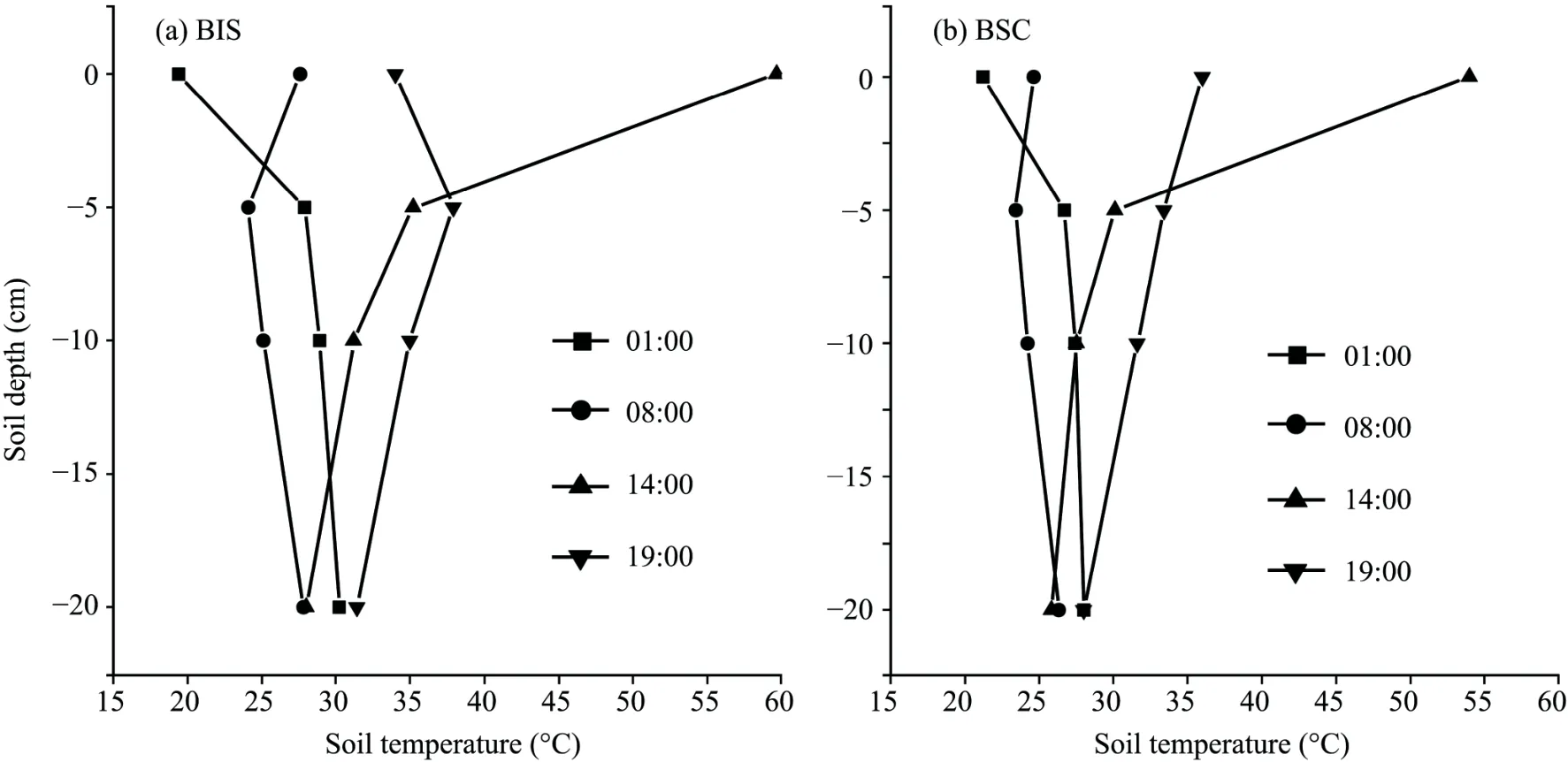
Figure 3 Vertical fluctuations of soil temperature that are (a) in the BIS and (b) within the BSC area in a typical clear day (August 6)

Figure 4 The diurnal mean variations of soil temperature during the experiment
3.3 Diurnal variations of soil temperature during precipitation
Figure 5 shows the diurnal variations of soil temperature that are within the BSC area and in the BIS and the accumulated precipitation curve in a rainy day (August 15).Figure 6 illustrates the vertical fluctuations of soil temperature that are within the BSC area and in the BIS.There was a total of 21.3 mm of rainfall in August 15,and it occurred at 03:30.When the rainfall occurred,the diurnal variation of soil temperature no longer showed the sinusoidal curve as in the clear days but decreased continually as rainfall continued.The vertical fluctuations of soil temperature increased with increasing soil depths,which is different from that in clear days (Figure 6).Soil temperature at 0 cm and 20 cm at BSC were lower than in the BIS.As rainfall continued,soil temperatures at BSC were increasingly close to that in the BIS.In rainy days,soil temperatures at the upper soil layer were mainly affected by rainfall and the shrub had negligible effects on soil temperatures,compared to those in clear days.
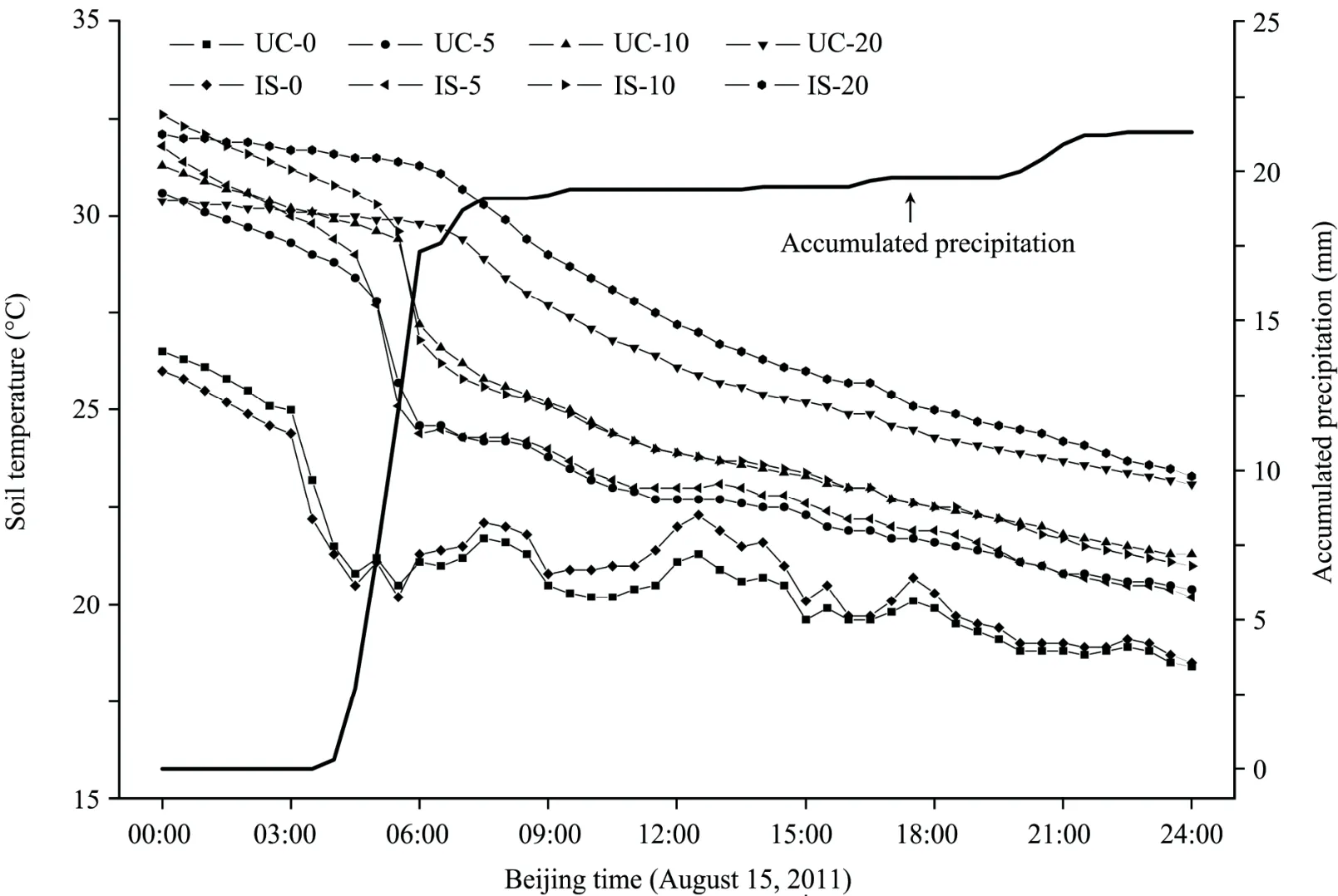
Figure 5 Diurnal variations of soil temperature that are within the BSC area and in the BIS and the accumulated precipitation curve in a rainy day (August 15)
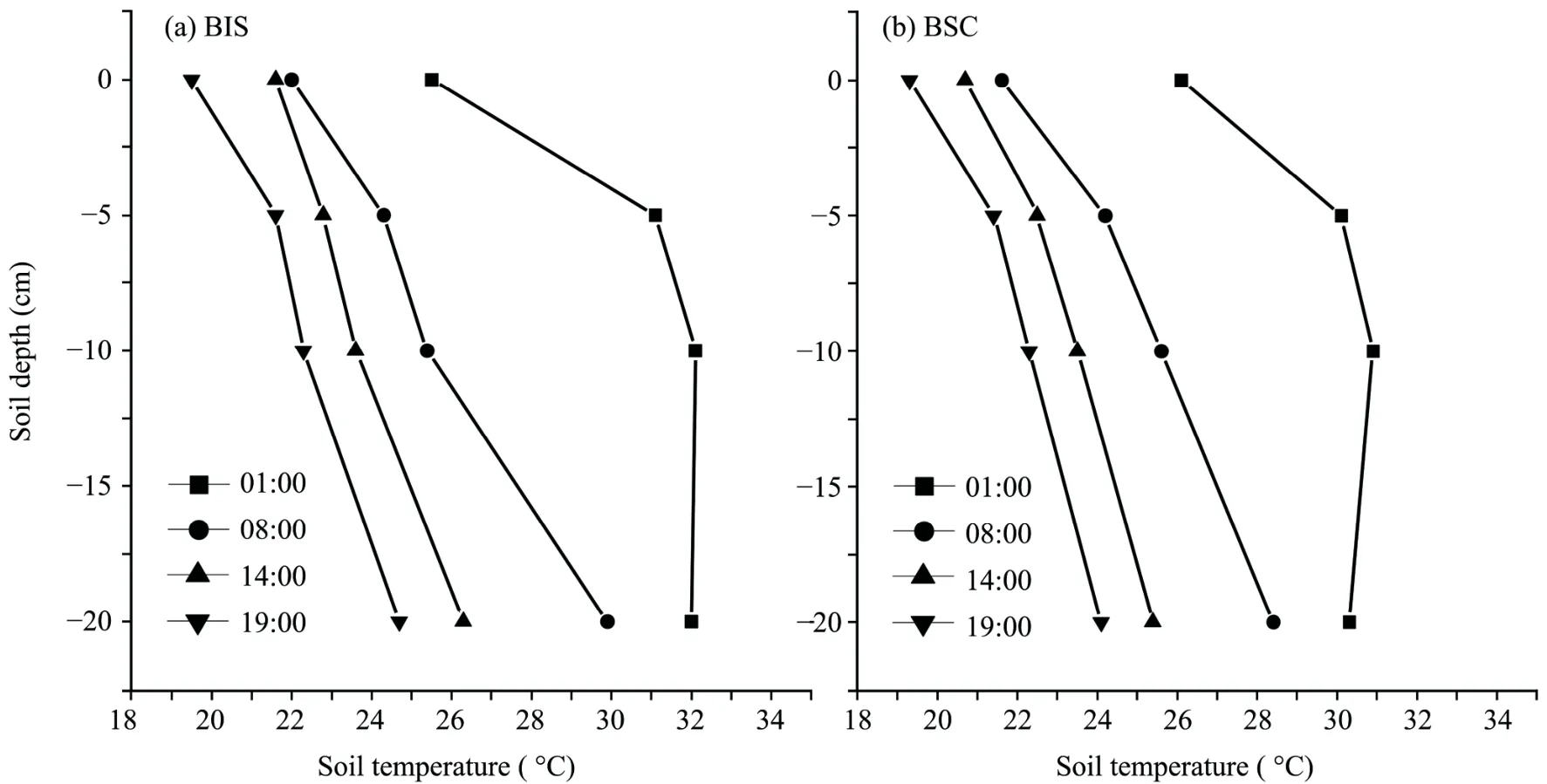
Figure 6 Vertical fluctuations of soil temperature that are (a) in the BIS and (b) within the BSC area in a rainy day (August 15)
4 Discussion and conclusions
Both precipitation and vegetation significantly affect soil temperatures.In rainy days,little difference in soil temperature at the same soil depth was found between the BSC area and BIS,and soil temperature was affected mainly by precipitation.In clear days,soil temperatures within the BSC area were significantly lower than in the BIS at the same soil depth due to the shading effects of shrub canopy.Diurnal variations of soil temperature showed a unimodal sinusoidal curve in clear days.The amplitude of soil temperature tended to decrease.In rainy days,diurnal variations in soil temperature decreased exclusively as rainfall continued and the vertical fluctuations of soil temperature showed an increased tendency with increasing soil depth.
Our study area experienced long term revegetation,which had turned a landscape with bare and homogeneous moving sand dunes into a landscape characterized by a mosaic of sparse shrubs and herbs and interspaces covered by biological soil crusts.Solar radiation was often very high and vegetation cover,precipitation and soil moisture were often very low,which resulted in higher soil temperature,especially for surface temperature in the daytime.For instance,the maximum surface temperature of bare sandy soil could be as high as 74 °C (Wanget al.,2002)."Cool islands" effect induced by shrubs may have provided a positive role in the succession of the revegetated ecosystem in the study area.Moreover,the biological soil crusts in the intershrub spaces had a lower surface albedo,suggesting a higher surface temperature at the surface of biological crusts than at sand surface (Liuet al.,2006;Zhanget al.,2012).Vegetation growth and survival increased the landscape heterogeneity and surface roughness in this desert ecosystem after revegetation,which greatly affected the heterogeneity of soil temperature,especially for surface temperature (Figures 1 and 2).Caragana korshinskiishows good performance in revegetation and is regarded as one of the chief sand-fixing shrubs in desert areas.Our results showed that the canopy ofC.korshinskiigreatly affects soil temperature especially during sunrise to sunset in clear days.Shrubs play a role of "cool islands" in the desert ecosystems,with lower soil temperature (especially surface temperature) within the BSC area than in the BIS,which may further affect the temperature-dependent near-surface biological processes such as seed germination,microbial activity and insect dynamics.According to the process in landscape succession,we concluded that revegetation increases surface roughness and landscape heterogeneity compared to the sand dunes,which enhances the microclimate and microhabitats and provides a favorable environment for other biological processes,facilitating the positive succession of this revegetated desert ecosystem.
In the daytime,soil temperatures within the BSC area were remarkable lower than in the BIS,because solar radiation was greatly attenuated through shrub canopy and solar radiation reaching the shaded soil by shrub canopy decreased.The extent of decreasing soil temperature is related to both canopy architecture and diurnal variation of solar altitude,which determines the size,shape and intensity of shade (El-Banaet al.,2002;Kidron,2009).In the nighttime,surface temperatures under the canopies were slightly higher than that in the intershrub spaces,which was in agreement with D’Odoricoet al.(2010) and Kidron (2010).Shrub canopy decreased the intensity of radiation cooling beneath canopy,resulting in a higher surface temperature within the BSC area in the nighttime.This phenomenon is unfavorable for dew formation beneath shrub canopy (Kidron,2010;Panet al.,2010).However,soil temperatures within the BSC area at other soil depths were always higher than in the BIS of the same depth (Figures 3 and 4).
In desert ecosystems,precipitation is scarce and pulsed,and it is the chief limiting factor for plant growth (Noy-Meir,1973).After a precipitation event,soil temperature decreased immediately,and the diurnal variations of soil temperature no longer showed the unimodal sinusoidal curve as in clear days but decreased as precipitation continued (Figure 5).Solar radiation was often weak in rainy days,and thus shrub canopy had weak influence on soil temperature.Precipitation greatly affected soil temperatures by increasing soil moisture and we assumed that the "cool islands" effects induced by shrub canopy had disappeared due to precipitation.The rainy season and hot season (June to September)occurred concurrently in the Shapotou area.Therefore,pulsed precipitation,to some extent,restrains the proceeding of higher soil temperatures,which would further facilitate plant growth,microbial activity and soil animals.
The authors are grateful to the editors and reviewer for constructive comments.This study was supported by the 100-Talents Program of the Chinese Academy of Sciences.
Berndtsson R,Nodomi K,Yasuda H,Persson T,Chen HS,Jinno K,1996.Soil water and temperature patterns in an arid desert dune sand.Journal of Hydrology,185:221-240.
Boulet G,Chehbouni A,Braud I,Vauclin M,1999.Mosaic versus dual source approaches for modelling the surface energy balance of a semi-arid land.Hydrology and Earth System Sciences,3:247-258.
Carpintero S,Reyes-Lopez J,Luque GM,2011.Ant community structure underRetamasphaerocarpashrubs in a semi-arid environment.Entomological Science,14(2):147-153.
Castellanos AE,Tinoco-Ojanguren C,Molina-Freaner F,1999.Microenvironmental heterogeneity and space utilization by desert vines within their host trees.Annals of Botany,84:145-153.
D’Odorico P,Fuentes JD,Pockman WT,Collins SL,He Y,Medeiros JS,Dewekker S,Litvak ME,2010.Positive feedback between microclimate and shrub encroachment in the northern Chihuahuan desert.Ecosphere,1(6):1-11.
El-Bana MI,Nijs I,Kockelbergh F,2002.Microenvironmental and vegetational heterogeneity induced by phytogenic nebkhas in an arid coastal ecosystem.Plant and Soil,247(2):283-293.
Franco AC,Nobel PS,1989.Effect of nurse plants on the microhabitat and growth of cacti.Journal of Ecology,77(3):870-886.
Goberna M,Pascual JA,Garcia C,Sanchez J,2007.Do plant clumps constitute microbial hotspots in semiarid Mediterranean patchy landscapes?Soil Biology Biochemistry,39:1047-1054.
Griffith AB,2010.Positive effects of native shrubs onBromustectorumdemography.Ecology,91:141-154.
Jia GM,Liu BR,Wang G,Zhang BL,2010.The microbial biomass and activity in soil with shrub (Caragana korshinskiiK.) plantation in the semi-arid loess plateau in China.European Journal of Soil Biology,46(1):6-10.
Kidron GJ,2009.The effect of shrub canopy upon surface temperatures and evaporation in the Negev Desert.Earth Surface Process and Landforms,34(1):123-132.
Kidron GJ,2010.Under-canopy microclimate within sand dunes in the Negev Desert.Journal of Hydrology,392:201-210.
Kuuluvainen T,Pukkala T,1989.Simulation of within-tree and between-tree shading of direct radiation in a forest canopy:Effect of crown shape and sun elevation.Ecological Modelling,49(1-2):89-100.
Li DL,Zhong HL,Wu QB,Zhang YJ,Hou YL,Tang MC,2005.Analyses on changes of surface temperature over Qinghai-Xizang Plateau.Plateau Meteorology,24:291-298.
Liu LC,Li SZ,Duan ZH,Wang T,Zhang ZS,Li XR,2006.Effects of microbiotic crusts on dew deposition in the restored vegetation area at Shapotou,northwest China.Journal of Hydrology,328(1-2):331-337.
Lowe CH,Hinds DS,1971.Effect of paloverde (Cercidium) trees on the radiation flux at ground level in the Sonoran Desert in winter.Ecology,52(5):916-922.
Ludwig F,de Kroon H,Prins HHT,Berendse F,2001.Effects of nutrients and shade on tree-grass interactions in an East African savanna.Journal of Vegetation Science,12(4):579-588.
Macduff JH,Wild A,Hopper MJ,Dhanoa MS,1986.Effects of temperature on parameters of root-growth relevant to nutrient-uptake-measurements on oilseed rape and barley grown in flowing nutrient solution.Plant and Soil,94(3):321-332.
Mayor MD,Boo RM,Pelaez DV,Elia OR,Tomas MA,2007.Influence of shrub cover on germination,dormancy and viability of buried and unburied seeds ofPiptochaetiumnapostaense(Speg.) Hackel.Journal of Arid Environments,68:509-521.
Molles MC,2008.Ecology:Concepts and Applications,4th ed.McGraw-Hill,New York.
Moro MJ,Pugnaire FI,Haase P,Puigdefabregas J,1997.Effect of the canopy ofRetamasphaerocarpaon its understorey in a semiarid environment.Functional Ecology,11:425-431.
Nobel PS,1984.Extreme temperatures and thermal tolerances for seedlings of desert succulents.Oecologia,62:310-317.
Noy-Meir I,1973.Desert ecosystems:environment and producers.Annual Review of Ecology and Systematics,4:25-51.
Pan YX,Wang XP,Zhang YF,2010.Dew formation characteristics in a revegetation-stabilized desert ecosystem in Shapotou area,Northern China.Journal of Hydrology,387(3-4):265-272.
Price MV,Reichman OJ,1987.Distribution of seeds in sonoran desert soils:implications for deteromyid rodent foraging.Ecology,68:1797-1811.
Raz-Yaseef N,Rotenberg E,Yakir D,2010.Effects of spatial variations in soil evaporation caused tree shading on water flux partitioning in a semi-arid pine forest.Agricultural and Forest Meteorology,150:454-462.
Rietkerk M,Dekker SC,de Ruiter PC,van de Koppel J,2004.Self-organized patchiness and catastrophic shifts in ecosystems.Science,305:1926-1929.
Scholes RJ,Archer SR,1997.Tree-grass interactions in savannas.Annual Review of Ecology and Systematics,28:517-544.
Shelef O,Groner E,2011.Linking landscape and species:Effect of shrubs on patch preference of beetles in arid and semi-arid ecosystems.Journal of Arid Environments,75(10):960-967.
Song CC,Wang YY,2006.Responses of soil temperature in wetland ecosystem to air temperature and their effects on CO2emission.Chinese Journal of Applied Ecology,17:625-629.
Souch CA,Souch A,1993.The effect of trees on summertime below canopy urban climates:a case study Bloomington,Indiana.Journal of Arboriculture,19:303-311.
Thomas WJ,Kliebenstein H,2000.Canopy architecture,light extinction and self-shading of a prairie grass,Andropogongerardii.The American Midland Naturalist,144(1):51-65.
Tracol Y,Gutierrez JR,Squeo FA,2011.Plant area index and microclimate underneath shrub species from a Chilean semiarid community.Journal of Arid Environments,75:1-6.
Valientebanuet A,Ezcurra E,1991.Shade as a cause of the association between the cactusNeobuxbaumia-tetetzoand the nurse plantMimosa luisanain the Tehuacan Valley,Mexico.Journal of Ecology,79(4):961-971.
Vetaas OR,1992.Micro-site effects of trees and shrubs in dry savannas.Journal of Vegetation Science,3:337-344.
Wang SY,Yang YX,Yang B,2003.Study on temperature of typical types of wetland soils and its influencing factors in the Sanjiang Plain.Geographical Research,22:389-396.
Wang XP,Li XR,Zhang JG,Zhou HY,Berndtsson R,2002.Variation of soil temperature and thermal diffusivity in vegetated and bare sand dunes in arid desert region.Journal of Desert Research,22:344-349.
Wang XP,Wang ZN,Cui Y,Pan YX,2010.Variation in soil seed banks composition at the desert microhabitats ofCaragana korshinskiishrubs.Arid Land Research and Management,24:238-252.
Yang MX,Yao TD,Ding YJ,Wang SL,Chen XZ,Koike T,Tadono T,1999.The diurnal variation of the soil temperature in the northern part of Tibetan Plateau.Environmental Science,20:5-8.
Zhang HZ,Shi XZ,Yu DS,Wang HJ,Zhao YC,Sun WX,Huang BR,2009.Seasonal and regional variations of soil temperature in China.Acta Pedologica Sinica,46(2):227-234.
Zhang YF,Wang XP,Pan YX,Hu R,2012.Diurnal relationship between the surface albedo and surface temperature in revegetated desert ecosystems,Northwestern China.Arid Land Research and Management,26(1):32-43.
Zou CB,Royer PD,Breshears DD,2010.Density-dependent shading patterns by Sonoran saguaros.Journal of Arid Environments,74:156-158.
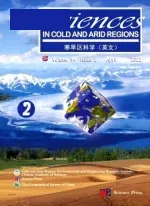 Sciences in Cold and Arid Regions2013年2期
Sciences in Cold and Arid Regions2013年2期
- Sciences in Cold and Arid Regions的其它文章
- Amount and temperature effects responsible for precipitation isotope variation in the southern slope of Himalayas
- Seasonal changes in the relationship between species richness and community biomass in grassland under grazing and exclosure,Horqin Sandy Land,northern China
- Afforestation effects on soil microbial abundance,microbial biomass carbon and enzyme activity in dunes of Horqin Sandy Land,northeastern China
- The effects of extreme rainfall events on carbon release from biological soil crusts covered soil in fixed sand dunes in the Tengger Desert,northern China
- Probabilistic modeling of soil moisture dynamics in a revegetated desert area
- OSL chronology and paleoclimatic implications of paleodunes in the middle and southwestern Qaidam Basin,Qinghai-Tibetan Plateau
